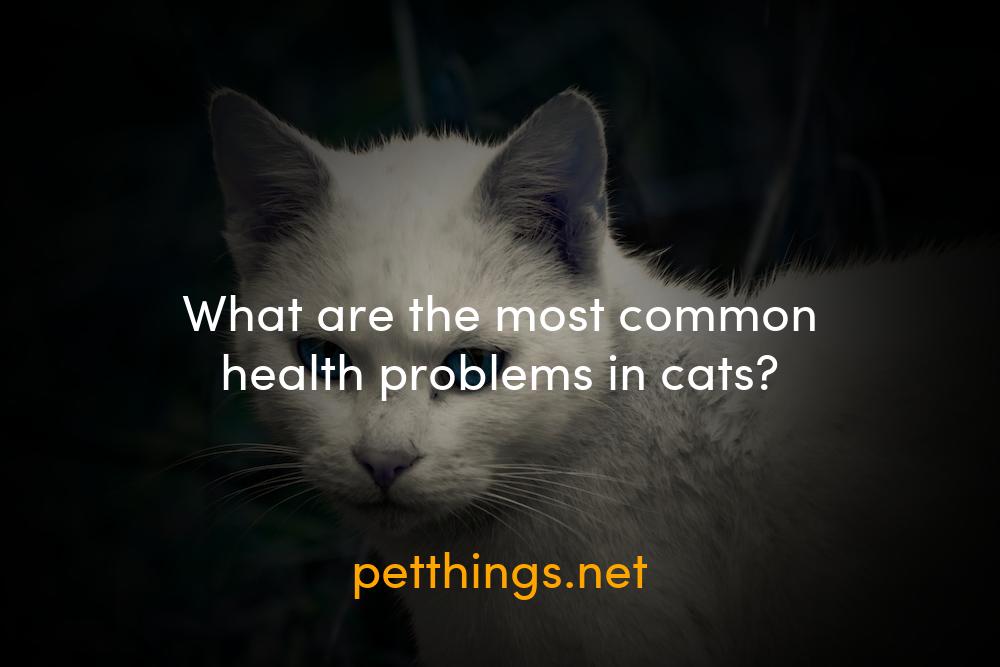Cats are popular pets all over the world, and their popularity means that there is a lot of information available about them.
However, there is also a lot of misinformation out there, and it can be difficult to figure out what is true and what is not.
This article will provide an overview of the most common health problems in cats, so that you can be informed about what to look for and how to best care for your feline friend.
- Vomiting.
- Feline Lower Urinary Tract Diseases (FLUTD)
- Fleas.
- Tapeworms.
- Diarrhea.
- Eye Problems.

Signs of a sick cat
- Changes in Appearance. If your cat is not feeling well, they may not look quite right
- Increased Vocalization
- Decreased Socialization
- Excessive Thirst
- Refusal to Eat
- Frequent Vomiting
- Weight Loss.
The Most Common Cause of Death in Cats
The most common reason for sudden death in cats is heart disease.
Even while an indoor lifestyle generally makes people safer than an outdoor one and increases life expectancy, indoor cats are nonetheless susceptible to serious infectious infections.
The feline distemper complex is made up of the feline panleukopenia virus, feline calici virus, and feline rhinotracheitis virus.
Covid Symptoms in Cats
- Fever.
- Coughing.
- Difficulty breathing or shortness of breath.
- Lethargy (unusual lack of energy or sluggishness)
- Sneezing.
- Runny nose.
- Eye discharge.
- Vomiting.
A cat may become ill for a variety of reasons, including parasites, fur balls, overeating or eating too quickly, trying new or unusual foods, or food allergies.
Ingesting harmful chemicals, pancreatitis, heat stroke, and digestive disorders are further causes.
Signs That a Cat Is Hurt Internally
- Reluctance to stand or walk.
- Pain upon lying down or rising.
- Stiff gait.
- Limping.
- Difficulty breathing.
- Whining.
- Lethargy.
- Decreased appetite or difficulty eating.
1. Feline Leukemia Virus, or FeLV, is the most common infectious disease that kills cats in the United States today.
The cat’s immune system is destroyed by FeLV, making him vulnerable to illnesses including anaemia, cancer, and infectious infections that a healthy cat would not contract.
The Stages of a Cat Dying
- Lack of Interest In Eating and Drinking. Like other animals, it’s common for cats to lose their appetite toward the end of their lives
- Extreme Weakness
- Lower Body Temperature
- Changes in Appearance and Smell
- Seeking Solitude.
Cats appear to be capable of foreseeing their own demise. A sick cat will frequently start looking for locations that are cosy for them but far from their owners.
Can You Get Sick From Kissing Your Cat?
On the other hand, I do not suggest kissing cats on the lips or attempting to kiss a sick cat.
Numerous illnesses can be transferred from cats to people (zoonotic). Common bacteria like salmonella, Pasteurella, staphylococcus, and E. coli can infect both cats and people.
Those are all quite contagious.
The First Signs of Feline Leukemia
- Loss of appetite.
- Weight loss.
- poor coat condition.
- Persistent fever.
- Inflammation of the gums and mouth.
- Skin, urinary, and upper respiratory tract infections.
- Persistent diarrhea.
- Seizures, behavior changes, and other neurological disorders.
Is it cruel to keep a cat indoors?
Is it crueller to restrict cats’ access to “the outside”? The majority of cats may live completely contentedly indoors, but owners must make an effort to meet their environmental and behavioural needs.
First Signs of Feline Leukemia
- Loss of appetite.
- Weight loss.
- Poor coat condition.
- Persistent fever.
- Inflammation of the gums and mouth.
- Skin, urinary, and upper respiratory tract infections.
- Persistent diarrhea.
- Seizures, behavior changes, and other neurological disorders.
The Typical Lifespan of a Cat
According to PetMD, most cats live 10–15 years , but this isn’t set in stone. Numerous factors, such as the environment, diet, and healthcare, affect how long your pet lives.
Domestic cats can live up to 20 years if they receive proper care, according to the Blue Cross.
The summary
The most prevalent infectious disease that kills cats in the United States today is FeLV, or feline leukaemia virus. According to Blue Cross, domestic cats can live up to 20 years if given the right care.
Cats often live for 10 to 15 years, but this isn’t a guarantee.
Citations
https://wagwalking.com/cat/conditions
https://www.cdc.gov/healthypets/pets/cats.html
https://firstvet.com/us/articles/common-diseases-in-cats
https://pets.webmd.com/cats/conditions
